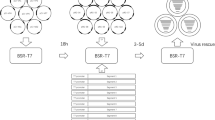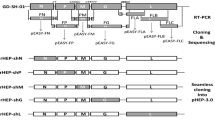Abstract
Based on the infectious full-length cDNA clone of rabbit hemorrhagic disease virus (RHDV), the in vitro transcripts are introduced into RK13 cells. 12 h later, CPE could be observed clearly, and virual antigen could also be detected by IFA. The titre of the recovered virus is 104.6/mL. Immune electron microscopic observation of the virus particles revealed that the particles were rotund with a diameter of about 30 nm. Besides, virus titre quantification obtained by qRT-PCR showed a correlation between time from infection and virus titre. All these results showed that we have recovered RHDV from RK13 cells by reverse genetics technology successfully, and this would be very useful in studies of the antigenicity, virulence, pathogenesis, maturation and new type vaccines of RHDV.
Similar content being viewed by others
Explore related subjects
Discover the latest articles and news from researchers in related subjects, suggested using machine learning.References
Lawson M. Rabbit virus threatens ecology after leaping the fence. Nature, 1995, 378: 531
Cubbitt D, Bradley D W, Carter M J, et al. Family Caliciviridae. Arch Virol, 1995, 10: 359–363
Rasschaert D, Huguet S, Madelaine M. F, et al. Sequence and genomic organization of a rabbit hemorrhagic disease virus isolated from a wild rabbit. Virus Genes, 1995, 9: 121–132
Gould A R, Kattenbelt J A, Lenghaus C, et al. The complete nucleotide sequence of rabbit haemorrhagic disease virus (Czech strain V351): Use of the polymerase chain reaction to detect replication in Australian vertebrates and analysis of viral population sequence variation. Virus Res, 1997, 47: 7–17
Daughenbaugh K F, Fraser C S, Hershey J W B, et al. The genome-linked protein VPg of the Norwalk virus binds eIF3, suggesting its role in translation initiation complex recruitment. EMBO J, 2003, 22: 2852–2859
Farnós O, Boué O, Parra F, et al. High-level expression and immunogenic properties of the recombinant rabbit hemorrhagic disease virus VP60 capsid protein obtained in Pichia pastoris. J Biotech, 2005, 117: 215–224
Liu G Q, Zhang Y Y, Ni Z, et al. Recovery of infectious rabbit hemorrhagic disease virus from rabbit after direct inoculation with in vitro-transcribed RNA. J Virol, 2006, 80(13): 6686–6690
Du N X, Xu W Y, Liu S J, et al. Studys on rabbit hemorrhagic disease virus. Agri Sci China, 1991, 24: 1–10
Luo J, Yang X L, Liu H, et al. Studys on the in vitro replication of rabbit hemorrhagic disease virus. Virologica Sinica, 1992, 7: 143–149
Ji C Y, Gong X M, Du N X. Systematic morphogenesis of the rabbit haemorrhagic disease virus in infected cell cultures and tissues. Chin J Veterin Sci, 1999, 19: 451–455
Author information
Authors and Affiliations
Corresponding author
About this article
Cite this article
Liu, G., Ni, Z., Yun, T. et al. Rescued virus from infectious cDNA clone of rabbit hemorrhagic disease virus is adapted to RK13 cells line. CHINESE SCI BULL 51, 1698–1702 (2006). https://doi.org/10.1007/s11434-006-2044-x
Received:
Accepted:
Issue Date:
DOI: https://doi.org/10.1007/s11434-006-2044-x




